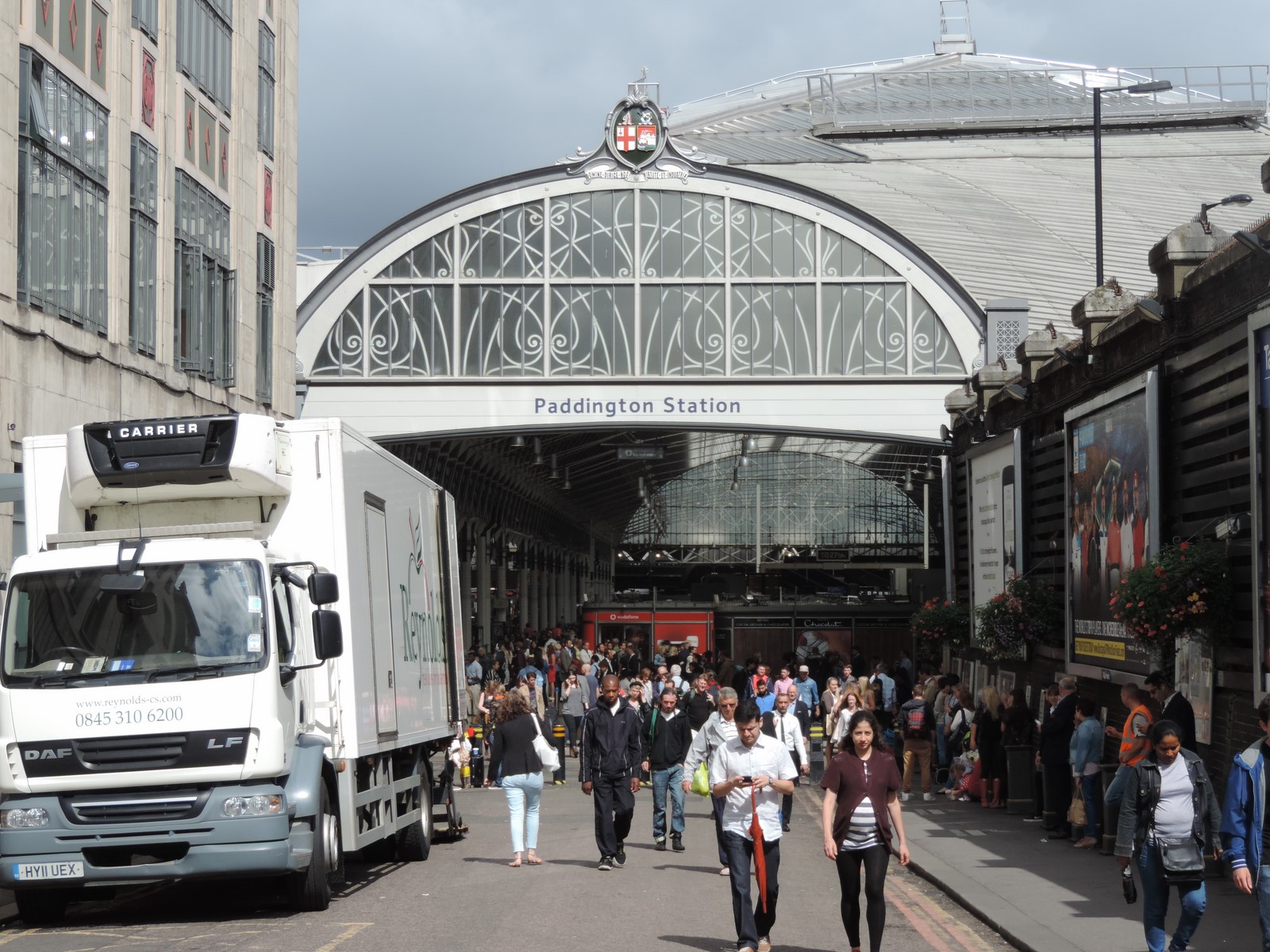 London Paddington station, often shortened to simply Paddington, is a central London railway terminus and London Underground station complex in fare zone 1. The site has been the London terminus of the Great Western Railway and its successors since 1838. Much of the mainline station dates from 1854 and was designed by Isambard Kingdom Brunel. The site was first served by Underground trains in 1863, as the original western terminus of the Metropolitan Railway, the world's first underground railway.
London Paddington station, often shortened to simply Paddington, is a central London railway terminus and London Underground station complex in fare zone 1. The site has been the London terminus of the Great Western Railway and its successors since 1838. Much of the mainline station dates from 1854 and was designed by Isambard Kingdom Brunel. The site was first served by Underground trains in 1863, as the original western terminus of the Metropolitan Railway, the world's first underground railway.
The station is the London terminus for First Great Western, which provides the majority of commuter and regional services to West London, the Thames Valley region and long-distance intercity services to South West England and South Wales. Destinations served include Reading, Bristol, Cardiff, Swansea, Oxford, Newbury, Taunton, Exeter, Plymouth, Penzance, Cheltenham, Worcester and Hereford. Paddington is also the London terminus for the Heathrow Express, which provides fast train services to London Heathrow Airport.
Paddington is one of 19 stations managed by Network Rail.
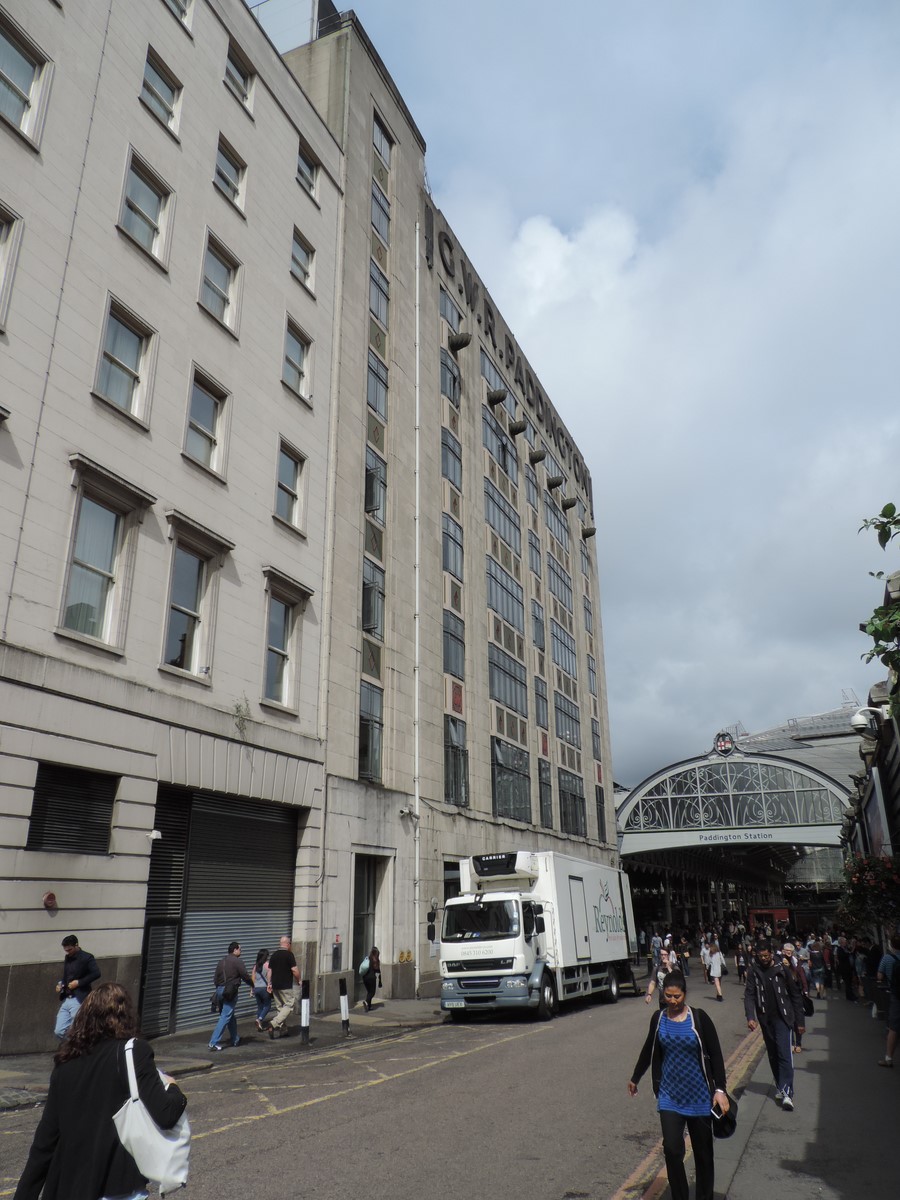 The station complex is bounded at the front by Praed Street and at the rear by Bishop's Bridge Road, which crosses the station throat on the recently replaced Bishop's Bridge. On the west side of the station is Eastbourne Terrace, while the east side is bounded by the Paddington arm of the Grand Union Canal. The station is in a shallow cutting, a fact obscured at the front by a hotel building, but which can be clearly seen from the other three sides.
The station complex is bounded at the front by Praed Street and at the rear by Bishop's Bridge Road, which crosses the station throat on the recently replaced Bishop's Bridge. On the west side of the station is Eastbourne Terrace, while the east side is bounded by the Paddington arm of the Grand Union Canal. The station is in a shallow cutting, a fact obscured at the front by a hotel building, but which can be clearly seen from the other three sides.
The surrounding area is partly residential, and includes the major St Mary's Hospital, restaurants and hotels.
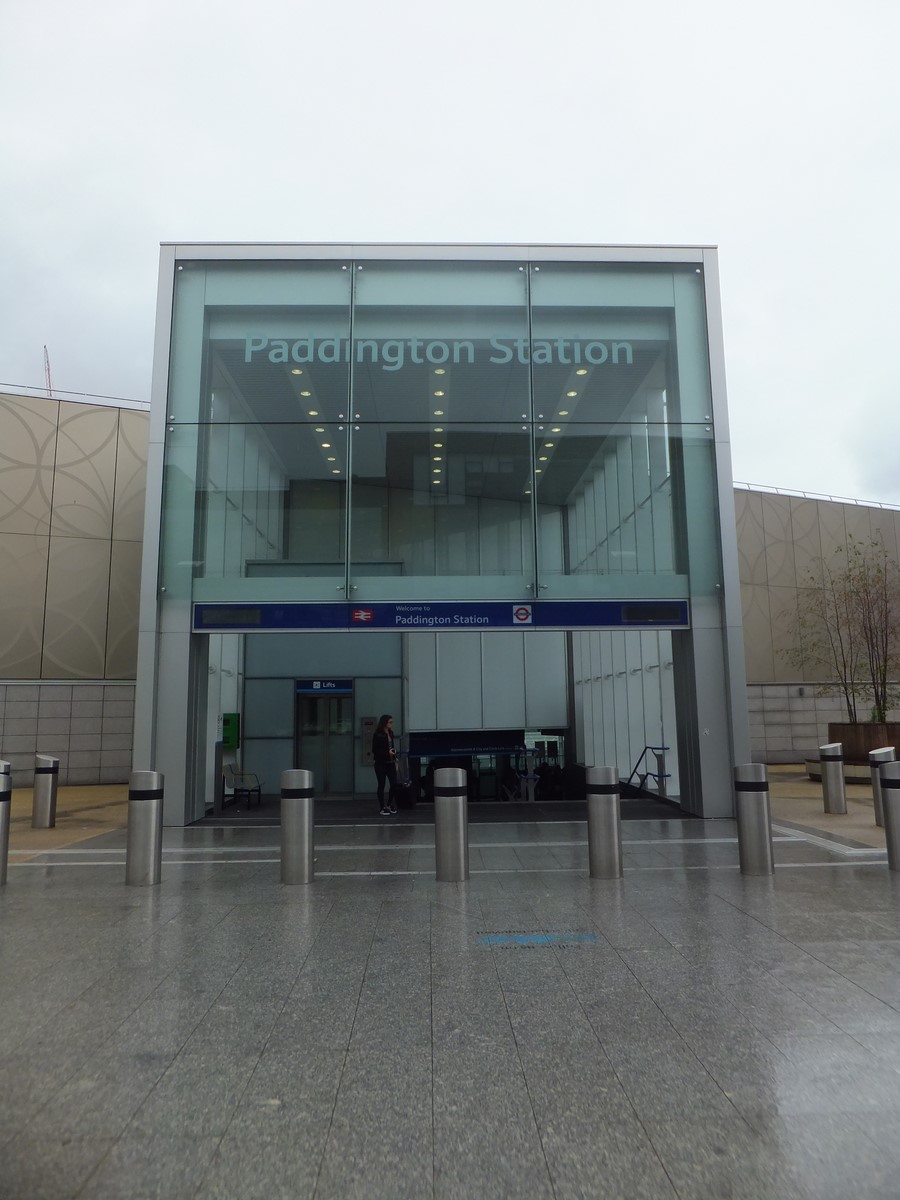 The National Rail station is officially named London Paddington, a name commonly used outside London but rarely by Londoners, who call it just Paddington, as on the London Underground map. Parts of the station, including the main train shed, date from 1854, when it was built by Isambard Kingdom Brunel as the London terminus for the Great Western Railway (GWR). It is one of 19 stations managed by Network Rail.
The National Rail station is officially named London Paddington, a name commonly used outside London but rarely by Londoners, who call it just Paddington, as on the London Underground map. Parts of the station, including the main train shed, date from 1854, when it was built by Isambard Kingdom Brunel as the London terminus for the Great Western Railway (GWR). It is one of 19 stations managed by Network Rail.
The first station was a temporary terminus for the GWR on the west side of Bishop's Bridge Road, opened on 4 June 1838. The first GWR service from London to Taplow, near Maidenhead, ran from Paddington in 1838. After the main station opened in 1854, this became the site of the goods depot.
The main station between Bishops Bridge Road and Praed Street was designed by Brunel, who was commemorated by a statue on the concourse (since moved to Platform 1, by the exit to the former taxi rank), although much of the architectural detailing was by his associate Matthew Digby Wyatt. It opened on 29 May 1854. The glazed roof is supported by wrought iron arches in three spans, respectively spanning 68 feet (21 m), 102 feet (31 m) and 70 feet (21 m). The roof is 699 feet (210 m) long, and the original roof spans had two transepts connecting the three spans. It is commonly believed that these were provided by Brunel to accommodate traversers to carry coaches between the tracks within the station. However recent research, using early documents and photographs, does not seem to support this belief, and their actual purpose is unknown.
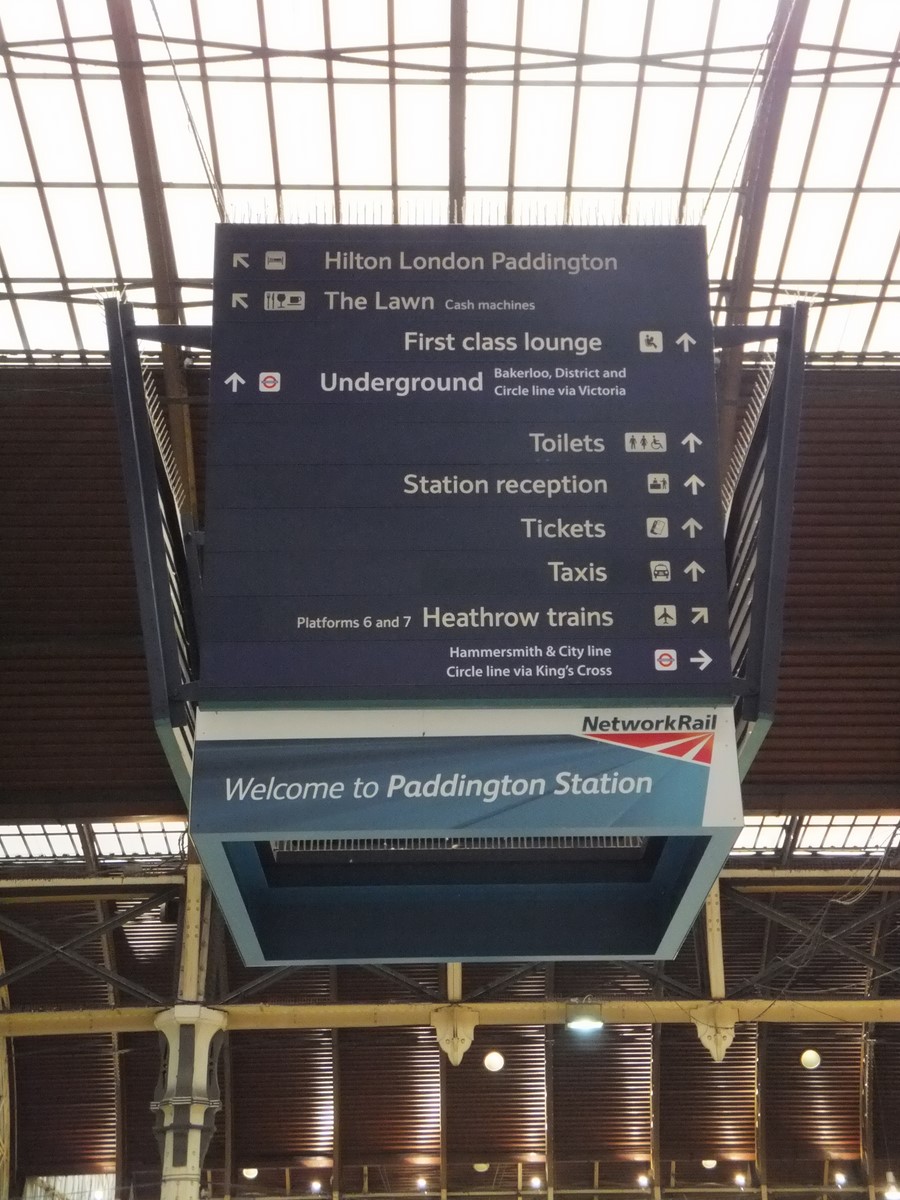 The Great Western Hotel was built on Praed Street in front of the station in 1851-1854 by architect Philip Charles Hardwick, son of Philip Hardwick (designer of the Euston Arch). The station was substantially enlarged in 1906-1915 and a fourth span of 109 feet (33 m) was added on the north side, parallel to the others. The new span was built in a similar style to the original three spans, but the detailing is different and it has no transepts.
The Great Western Hotel was built on Praed Street in front of the station in 1851-1854 by architect Philip Charles Hardwick, son of Philip Hardwick (designer of the Euston Arch). The station was substantially enlarged in 1906-1915 and a fourth span of 109 feet (33 m) was added on the north side, parallel to the others. The new span was built in a similar style to the original three spans, but the detailing is different and it has no transepts.
On Armistice Day 1922, a memorial to the employees of the GWR who died during the First World War was unveiled by Viscount Churchill. The bronze memorial, depicting a soldier reading a letter, was sculpted by Charles Sargeant Jagger and stands on platform 1.
A very early construction by Brunel was recently discovered immediately to the north of the station. A cast-iron bridge carrying the Bishop's Bridge Road over the Paddington arm of the Grand Union Canal was uncovered after removal of brick cladding during the replacement of the adjacent bridge over the railway lines at the mouth of the station.
The band Supertramp recorded the train sounds featured in the song "Rudy" in the 1974 album Crime of the Century in the station.
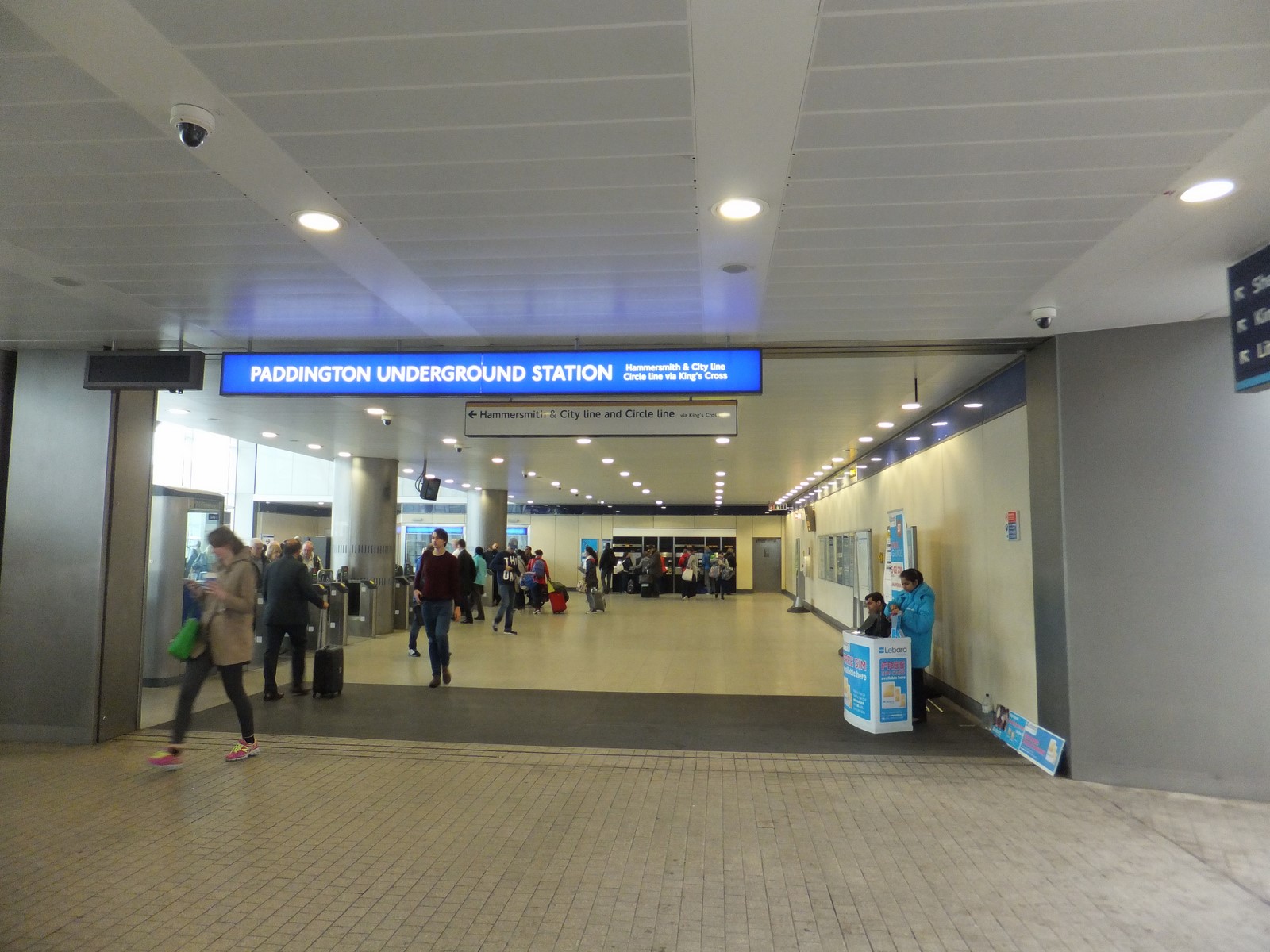 Paddington has 14 terminal platforms, numbered 1 to 14 from south-west to north-east (left to right as seen from the concourse). Platforms 1 to 8 are below the original three spans of Brunel's train shed, platforms 9 to 12 beneath the later fourth span. Platforms 13 and 14 are within the Metropolitan Railway's old Bishop's Road (Suburban) station to the north-west. Immediately alongside are through platforms 15 and 16, used by the London Underground's Hammersmith & City and Circle lines.
Paddington has 14 terminal platforms, numbered 1 to 14 from south-west to north-east (left to right as seen from the concourse). Platforms 1 to 8 are below the original three spans of Brunel's train shed, platforms 9 to 12 beneath the later fourth span. Platforms 13 and 14 are within the Metropolitan Railway's old Bishop's Road (Suburban) station to the north-west. Immediately alongside are through platforms 15 and 16, used by the London Underground's Hammersmith & City and Circle lines.
Platforms 6 and 7 are dedicated to the Heathrow Express, and platforms 13 and 14 can be used only by local services' Turbo trains up to seven cars long. Platforms 1 to 5 and 8 to 12 can be used by any services, but long-distance trains generally use the south-western platforms, and local trains (including Heathrow Connect) the north-eastern ones.
The concourse stretches across the heads of platforms 1 to 12, underneath the London end of the four train sheds. Platforms 13 and 14 can only be reached indirectly via the north-western end of platform 12, or from the footbridge which crosses the north-western end of the station and gives access to all platforms.
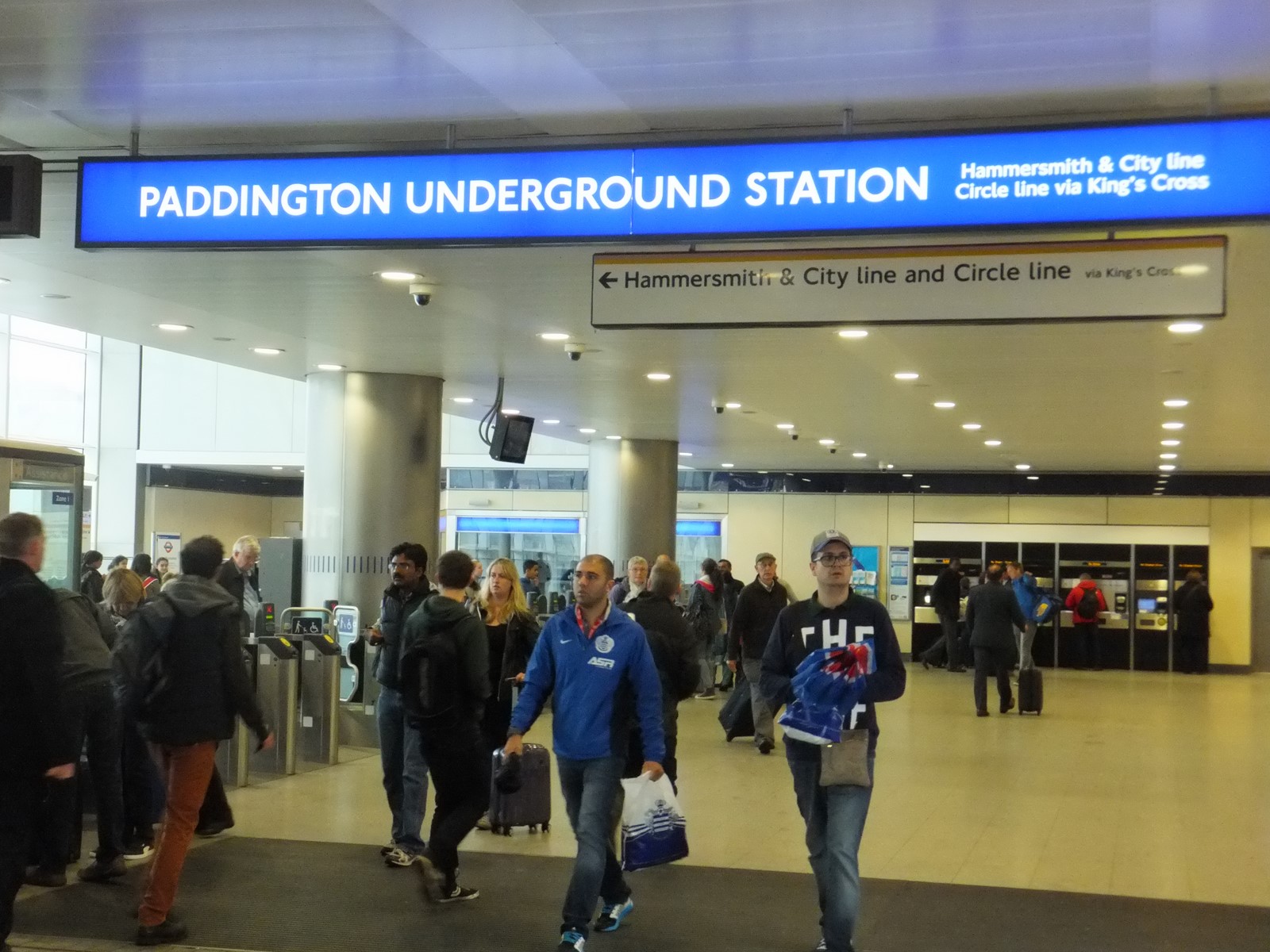 The area between the rear of the Great Western Hotel and the concourse is traditionally called The Lawn. It was originally unroofed and occupied by sidings, but was later built up to form part of the station's first concourse. The Lawn has recently been re-roofed and separated from the concourse by a glass screen wall. It is surrounded by shops and cafés on several levels.
The area between the rear of the Great Western Hotel and the concourse is traditionally called The Lawn. It was originally unroofed and occupied by sidings, but was later built up to form part of the station's first concourse. The Lawn has recently been re-roofed and separated from the concourse by a glass screen wall. It is surrounded by shops and cafés on several levels.
There are ticket barriers to platforms 2–5 and 10–16.
 Heathrow Express provides flight information display screens and self-check-in facilities for airline passengers at the Heathrow Express ticket office near the dedicated Heathrow Express platforms 6 and 7. Baggage check-in facilities for airline passengers were provided in 1999 in the Lawn but progressively replaced by retail units.
Heathrow Express provides flight information display screens and self-check-in facilities for airline passengers at the Heathrow Express ticket office near the dedicated Heathrow Express platforms 6 and 7. Baggage check-in facilities for airline passengers were provided in 1999 in the Lawn but progressively replaced by retail units.
Paddington is the London terminus for long-distance high-speed trains operated by First Great Western.
Paddington is served by four London Underground lines through two separate stations: the Bakerloo, Circle and District lines have a combined sub-surface and deep-level station to the south of the main line station, and the Hammersmith & City and Circle lines have a sub-surface station to the north. Circle line services go through both of the sub-surface stations as part of a spiral route. Although shown on the London Underground map as a single station, the two sub-surface parts are not directly linked.
Although Paddington is not served by the Central line, the short walk to Lancaster Gate tube station is taken by many commuters heading for the West End or the City, as it can be quicker than alternative routes.
The first underground railway station was opened as Paddington (Bishop's Road) by the Metropolitan Railway (MR) on 10 January 1863 as the terminus of the line from Farringdon. The station was to the north of the main line station and, from 13 June 1864, MR services were extended westward via a connection to the GWR's Hammersmith branch, now the Hammersmith & City line.
On 1 October 1868, the MR opened a branch to Gloucester Road, with a station called Paddington (Praed Street) in a cut-and-cover tunnel parallel to that street south of the mainline station. The deep-level Baker Street and Waterloo Railway (now the Bakerloo line) station opened on 1 December 1913 as a temporary terminus of an extension from Edgware Road to Queen's Park.
Services on what became the Circle line in 1949 were originally shared by the MR and the District Railway. Hammersmith & City line services were originally operated as part of the MR (later the Metropolitan line) and were separately identified as the Hammersmith & City line in 1990.
From December 2009, the Circle line was altered so that trains run in a spiral from Hammersmith via Ladbroke Grove to the Bishops Road platforms at Paddington, then on to Edgware Road, Kings Cross, Tower Hill, Victoria, High Street Kensington and back to Edgware Road via the Praed Street platforms at Paddington. This means that eastbound trains from the District and Circle line platforms all terminate at Edgware Road, the next station. Passengers for stations beyond Edgware Road either have to change there, or use services from the Hammersmith & City line platforms. All trains towards King's Cross now leave from the same platform, instead of being split between two platforms some distance apart.
The platforms of the Hammersmith & City and Circle lines (Bishop's Road) station are still separate from the other Underground platforms; they are numbered (15 and 16) in the same sequence as the mainline platforms. Interchange between the Bakerloo, District and Circle line platforms and the Hammersmith & City and Circle line platforms involves walking the length of the mainline station outside the Underground barrier lines, although the ticket barriers are programmed to permit changing between the two stations as part of a single journey.
Hammersmith & City line trains run between Hammersmith and Barking via Paddington (Suburban) platforms 15 and 16. Circle line trains share tracks with the Hammersmith & City line from Hammersmith to Liverpool Street, then around a clockwise loop via Aldgate and Victoria, arriving back at Paddington (Praed Street), before terminating at Edgware Road. District line services run between Wimbledon and Edgware Road, and Bakerloo line trains run between Elephant & Castle and Harrow & Wealdstone stations.
London Buses routes 7; 23; 27; 36; 46; 205; 332; 436 and night route N7 and N205 serve the station.